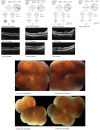Dexamethasone implantation in birdshot chorioretinopathy - long-term outcome
- PMID: 30555265
- PMCID: PMC6280912
- DOI: 10.2147/IMCRJ.S164206
Dexamethasone implantation in birdshot chorioretinopathy - long-term outcome
Abstract
Purpose: To evaluate the long-term efficacy of the 0.70 mg dexamethasone (DEX) intravitreal implant in patients with birdshot chorioretinopathy (BSCR).
Methods: Retrospective descriptive case series of BSCR patients treated with DEX implant (DEX implant 0.70 mg, DEX). Patients receiving treatment between September 2013 and November 2016 with a minimum follow-up (FU) of 12 months were included. The outcomes of primary interest were vision-related functioning, Snellen visual acuity, ocular inflammation status, presence or absence of vasculitis, change in central macular thickness, and development of glaucoma and/or cataract. Change in vision-related functioning was evaluated by comparing the National Eye Institute Visual Function Questionnaire-25. The outcomes were assessed at baseline, after DEX implant, at time of relapse, and at last FU.
Results: Three patients (six eyes) were included in the study and were followed for 1-3 years. They received 1-4 DEX implants OU. All patients demonstrated improvement in National Eye Institute Visual Function Questionnaire-25 scores. Mean Snellen visual acuity better than or equal to 20/40 was seen in three eyes at baseline and five eyes at last FU. At induction, all of the patients (six eyes) had active vitritis and two (four eyes) had retinal vasculitis. All three patients (six eyes) were quiet at last FU. One patient (two eyes) developed bilateral ocular hypertension requiring topical therapy and discontinuation of DEX implants. Two patients (three eyes) developed posterior subcapsular cataract during therapy. Two patients (four eyes) showed progression of disease while on DEX therapy. All patients were eventually transitioned to systemic immunosuppressive drug therapy.
Conclusion: BSCR patients receiving DEX implant experienced clinically meaningful improvements in patient-reported visual function as well as ocular inflammation. However, patients in this study required repeat implantation and were unable to be maintained on DEX implant long term due to development of adverse effects or progression of disease. Eventually, it was necessary to transition to systemic immunosuppressive therapy in all patients.
Keywords: birdshot chorioretinopathy; dexamethasone implant; inflammation; uveitis.
Conflict of interest statement
Disclosure The authors report no conflicts of interest in this work.
Figures



Similar articles
-
Efficacy and tolerability of bilateral sustained-release dexamethasone intravitreal implants for the treatment of noninfectious posterior uveitis and macular edema secondary to retinal vein occlusion.Clin Ophthalmol. 2015 Jun 23;9:1109-16. doi: 10.2147/OPTH.S84207. eCollection 2015. Clin Ophthalmol. 2015. PMID: 26150689 Free PMC article.
-
INTRAVITREAL DEXAMETHASONE IMPLANTATION FOR BIRDSHOT CHORIORETINOPATHY.Retin Cases Brief Rep. 2017 Winter;11(1):51-55. doi: 10.1097/ICB.0000000000000287. Retin Cases Brief Rep. 2017. PMID: 26982209
-
Intravitreal Dexamethasone Implant in the Treatment of Non-infectious Uveitis.Turk J Ophthalmol. 2019 Oct 24;49(5):250-257. doi: 10.4274/tjo.galenos.2019.81594. Turk J Ophthalmol. 2019. PMID: 31650791 Free PMC article.
-
Birdshot Chorioretinopathy: A Review.J Clin Med. 2022 Aug 16;11(16):4772. doi: 10.3390/jcm11164772. J Clin Med. 2022. PMID: 36013011 Free PMC article. Review.
-
Birdshot uveitis: current and emerging treatment options.Clin Ophthalmol. 2014;8:73-81. doi: 10.2147/OPTH.S54832. Epub 2013 Dec 18. Clin Ophthalmol. 2014. PMID: 24379650 Free PMC article. Review.
Cited by
-
Optic Disc Edema Is an Under-Recognized Feature of Birdshot Chorioretinitis.J Neuroophthalmol. 2024 Dec 1;44(4):545-551. doi: 10.1097/WNO.0000000000002085. Epub 2024 Jan 25. J Neuroophthalmol. 2024. PMID: 38271082 Free PMC article.
-
Intraocular therapy in noninfectious uveitis.J Ophthalmic Inflamm Infect. 2021 Oct 10;11(1):37. doi: 10.1186/s12348-021-00267-x. J Ophthalmic Inflamm Infect. 2021. PMID: 34632541 Free PMC article. Review.
-
Dexamethasone intravitreal implant for macular edema and some other rare indications in uveitis.Med Int (Lond). 2023 Jul 19;3(4):39. doi: 10.3892/mi.2023.99. eCollection 2023 Jul-Aug. Med Int (Lond). 2023. PMID: 37560325 Free PMC article.
-
Intravitreal Dexamethasone Implant as a Sustained Release Drug Delivery Device for the Treatment of Ocular Diseases: A Comprehensive Review of the Literature.Pharmaceutics. 2020 Jul 26;12(8):703. doi: 10.3390/pharmaceutics12080703. Pharmaceutics. 2020. PMID: 32722556 Free PMC article. Review.
-
A New Era in Ocular Therapeutics: Advanced Drug Delivery Systems for Uveitis and Neuro-Ophthalmologic Conditions.Pharmaceutics. 2023 Jul 14;15(7):1952. doi: 10.3390/pharmaceutics15071952. Pharmaceutics. 2023. PMID: 37514137 Free PMC article. Review.
References
-
- Levinson RD, Brezin A, Rothova A, Accorinti M, Holland GN. Research criteria for the diagnosis of birdshot chorioretinopathy: results of an international consensus conference. Am J Ophthalmol. 2006;141(1):185–187. - PubMed
-
- Shah KH, Levinson RD, Yu F, et al. Birdshot chorioretinopathy. Surv Ophthalmol. 2005;50(6):519–541. - PubMed
-
- Ryan SJ, Maumenee AE. Birdshot retinochoroidopathy. Am J Ophthalmol. 1980;89(1):31–45. - PubMed
-
- Kaplan HJ, Aaberg TM. Birdshot retinochoroidopathy. Am J Ophthalmol. 1980;90(6):773–782. - PubMed
LinkOut - more resources
Full Text Sources

